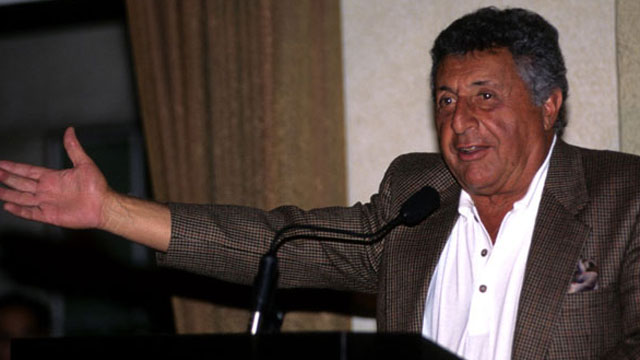NEWS
Golf producer Chirkinian receives '96 PGA Distinguished Service Award

Note: This is the story released by The PGA of America in 1996, when Frank Chirkinian received the PGA Distinguished Service Award.
PALM BEACH GARDENS, Fla. -- Today’s high-tech, up-close-and-personal world of televised professional golf was once a shapeless and vanilla package. Televised golf of the 1950s needed a renaissance and found a leader in Frank Chirkinian.
In 1958, when the PGA Championship transformed match to stroke-play, it also brought network television inside the gallery ropes at Llanerch Country Club in suburban Philadelphia. That decision evolved from a meeting between The PGA of America and the CBS Network at the Warwick Hotel in Philadelphia.
A key member of that group was Chirkinian, then a 32-year-old studio director at CBS-owned WCAU-TV. He possessed a rare talent, which would transform golf on television into a tapestry of vivid images. Chirkinian became a director for CBS in 1959 and embarked on a fascinating career spanning four decades. His work exposed the game of golf to millions of fans who embraced it.
“Frank knew the game of golf so well, and he also understood the medium of television,” said Ray Scott, a former 18-year CBS football and golf broadcaster. “Frank set the standard for excellence.”
Given free rein by CBS to mold a golf telecast, Chirkinian innovations became industry standards. From televising the final three holes for 55 minutes that Sunday in 1958, he gradually expanded PGA Championship coverage to all 18 holes televised during the final two rounds. Through his guidance, professional golf evolved into a mass stage production for millions of viewers. By placing microphones near the tee boxes, Chirkinian brought the sounds of the game into the nation’s living rooms. He recruited some outstanding golf professionals for the broadcast booth. He introduced hand-held cameras on the course to bring the game’s finest performers virtually next to the viewer.
When network commitments challenged him to condense a full day of golf into several hours, Chirkinian didn’t miss a beat and sustained viewer interest. A golf telecast by Chirkinian kept the view abreast of how any player stood on the leaderboard thanks to a scoring system – now universally recognized – that listed all scores at under or over par.
Golf from all angles was a Chirkinian staple, such as perching broadcasters and cameras in towers at strategic positions on the course. Chirkinian also was the first to direct a camera be positioned in a blimp – at the 1962 Orange Bowl. It wasn’t long before blimps dotted the sky above golf tournaments.
“There wasn’t an expert in televising golf before Frank,” says John Derr, a longtime Chirkinian friend and veteran broadcaster. “Frank wrote the book.”
“Frank’s instinct about the game is uncanny,” says Ken Venturi, whom Chirkinian recruited as a broadcaster 29 years ago. “He once ordered we switch to a player away from the leaders and we caught a hole-in-one live. He has two rules: First, if I have to tell you what to say then you don’t belong; and secondly, it’s just as important what you don’t say in golf.”
Born of parents of Armenian descent, Chirkinian was one of two children. His father, Samuel, ran a dry cleaning establishment that he hoped would someday be managed by his son.
However, Frank had always been an entertainer, a frustrated nightclub singer who was enamored with the legendary Frank Sinatra. After attending the University of Pennsylvania for two years, Chirkinian entered the television industry. During this transition, however, he often sought singing engagements at clubs throughout the Philadelphia area.
“If there ever was a song that fit dad, it was Sinatra’s ‘I Did it My Way,’ “ says his son, Frank Jr., a former independent television producer turned real estate investor in Highland Beach, Fla. “He has always had a propensity to entertain people. And, he had the propensity to lead. Whether it’s innate or not, it requires a measure of bravery. He thrives under pressure and is someone who needs a degree of pressure to do his best.”
Chirkinian won the first of two Peabody Awards for excellence in producing network coverage of the 1960 winter and summer Olympic Games, followed by a Peabody for the 1991 Masters. He preceded those honors by winning four Emmy Awards: “Winner Takes All,” in tennis (1976); the Ali-Spinks heavyweight championship fight (1978); the CBS Golf Classic (1966), and the PGA Tour on CBS (1981).
“Frank has a sense of theater that elevates him from an average director into a great director,” says Chuck Will, a former associate producer of CBS Sports and a longtime Chirkinian golf partner. “He loves the game which is why he has been able to carry his enthusiasm throughout the years.”
Tonight, The PGA of America bestows its Distinguished Service Award on Frank Chirkinian, a man whose professional career has made a universal impact on golf and the life and livelihood of the PGA Professional. Frank Chirkinian blazed a path that enabled millions to appreciate the game of golf and its lifetime benefits.
